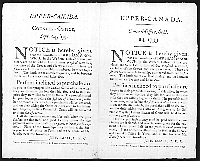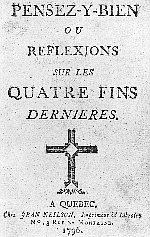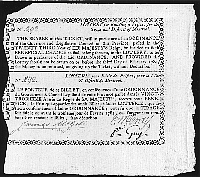| Contents | Next article |
![]()
![]()
| Contents | Next article |

October/November 1996, vol. 28, nos. 10-11
by Patricia Fleming, Professor, Faculty of Information Studies, University of Toronto
In his essay on the early years of the Bibliographical Society of Canada recently published in the National Library News, W. Kaye Lamb celebrated the achievement of some of Canada’s founding bibliographers with the prediction that their work is never likely to be superseded (see “Early Days: Personal Reflections on the Founding of the Bibliographical Society of Canada”, National Library News vol. 28, no. 6, June, 1996, pp. 7-8). As one of the successors to Marie Tremaine, I heartily agree.1
When I first began to study printing in early Canada, the need to continue her research into the nineteenth century was clear.2 Searching for Ontario and Atlantic imprints, sometimes guided by her citations, I started to accumulate a file of unrecorded or unlocated eighteenth-century printing. Meanwhile, Marie Tremaine’s generous bequest to the Bibliographical Society at her death in 1984 called for a response. The Society established the Tremaine Fellowship in 1987 as one way of sharing her legacy with the scholarly community. Another would be to update and bring back into print her Bibliography of Canadian Imprints, 1751-1800, the cornerstone of bibliography and book history studies in Canada. I enlisted Sandra Alston, who had prepared a supplement to another bibliography in which Tremaine was a collaborator,3 and we began work on the new Tremaine in 1989. The University of Toronto Press, which holds the 1952 copyright, expressed interest in publishing a revised edition and the project received funding for travel from the Social Sciences and Humanities Research Council of Canada.
We decided to verify as many of Tremaine’s original library locations as possible, to identify additional copies, and to search for new entries. As we near the end of the project, we have examined well over 3 000 imprints in more than 50 libraries and archives in Canada, Britain and the United States. The current location notes also include CIHM reference numbers for items available as part of the microfiche collection of the Canadian Institute for Historical Microreproductions.
Revising Tremaine’s census of copies has revealed much about the growth of Canadian libraries over the last five decades. Strong collections such as those of the Séminaire de Québec (part of Laval University’s library in Tremaine’s time), the National Archives, and the Public Archives of Nova Scotia yielded many additional entries. University libraries at Dalhousie, McGill, and Toronto have kept pace with the growth in Canadian studies while new institutions, founded since the publication of Tremaine’s work in 1952, now hold significant collections of early printing, most notably the National Library of Canada and the Bibliothèque nationale du Québec. The former nearly doubled its collection of Tremaine items, now totalling more than 300 eighteenth-century imprints, with the transfer from the National Archives of its historical collections of published material in 1995. Other changes include the acquisition by Canadian libraries of 27 titles which Tremaine had located only in British or American repositories and the dispersal of private collections belonging to Georges-Alphonse Daviault, J.G. Hodgins, Fred Ketcheson and others. Some of their books are now available in public institutions with a record of ownership preserved.
 |
A substantial number of the imprints are part of manuscript collections and were difficult to locate using original citations. At the Public Record Office in Britain, for example, materials have been renumbered so that Tremaine’s volume and leaf notations are no longer accurate, often shifted by several hundred leaves. Fortunately, the National Archives filmed the Colonial Office files and copies are available in Ottawa and the provinces. The National Archives’ own collection of Tremaine items, which is scattered widely in official records and personal papers, was not so easily tracked as modern record groups were created in the 1950s, shortly after Tremaine found the imprints and cited their original locations. Patient scanning of microfilm was useful for some series. The work of Patricia Kennedy, then Chief, Pre-Confederation Archives, was more effective. She undertook a detailed analysis of Marie Tremaine’s use of the National Archives, inviting the current generation of bibliographers and book historians to expand on Tremaine’s use of financial records and the incomparable Neilson Papers.4 Michel Brisebois of the National Library has already responded with a study of job printing in early Quebec.5
Tracing copies of Tremaine’s entries and examining the twentieth copy as closely as the first one located are surely virtuous and certainly good bibliography, as shown in two editions of the same text of an Upper Canada land sale notice. The two are printed facing each other on a folded sheet. Why? We don’t have a solution to that puzzle but we can now answer the other questions which our colleagues have been asking. The first is: how many of Tremaine’s "Copy located: None" have you found? The second is: how many new or previously unrecorded imprints are you adding? Anyone who has used Tremaine will remember that more than a quarter of her 1 200 entries were not located. These imprints are meticulously documented from primary sources, such as government accounts, printers’ records, and newspaper notices but no copies were available. We have found more than 50 of them. Eleven are almanacs in both sheet and pamphlet format from Quebec and Nova Scotia, the latter including two years of Anthony Henry’s Der Neu-Schottlandische Calender. From the early months at Brown and Gilmore’s shop in Quebec, five 1764 imprints record a business dispute and incidentally show off the new Caslon type ornaments that Gilmore had recently bought in London. The New Brunswick radical James Glenie’s "damned and blasted pamphlet" is now available; so is the intriguing "Dialogue between Andre and Brigite" from Quebec.6 On the official side is Thomas Carleton’s first proclamation issued when he took charge of the new province of New Brunswick in 1784 and the Laws and Ordinances of the city of Saint John published in 1796. A Montreal edition of Aesop’s Select Fables is now located in four Canadian libraries while John Neilson’s Catalogue of English French and Latin Books for Sale at the Printing Office, published in 1800, is at Harvard.7 Another catalogue, which must be one of Canada’s earliest botanical works, is with the Dartmouth papers at the National Archives. In it John Wright of Quebec was offering native seeds packed for shipment from a numbered list of 584 varieties.8
 |
We are adding more than 200 new or previously unrecorded imprints to Tremaine. The first, a proclamation in French issued during the summer of 1752 by Peregrine Hopson, newly appointed governor of Nova Scotia, is now the earliest dated Canadian printing apart from issues of the Halifax Gazette. There are nine other Halifax imprints from the 1750s and six more from 1761 to 1762, an addition which almost doubles the recorded output of the press in that first decade. Most of these new entries are official proclamations regulating trade, land granting, the militia, and election of Nova Scotia’s first Assembly; they caution against damage to the new buoys in the harbour and the theft of wheelbarrows from the King’s Yard; one urges all persons to maintain a fair and just commerce with the Indians, while another calls for a day of thanksgiving. This Halifax section also includes an indenture binding as apprentices children from the Orphan House, Rules and Orders of the Union Fire Club, and a certificate of entry from the Custom House which is a recent acquisition at the National Library. Other not-in-Tremaines, imprints from each decade of the second half of the eighteenth century, are typical of the era. We have bills and laws, proclamations and almanacs, sermons, prayers, and devotional works. Political life appears in election notices from Quebec in 1792 and 1796 and Upper Canada in 1800. There is a political satire by the loyalist Edward Winslow and a 1794 pamphlet, Les Français Libres à leurs Frères les Canadiens, which the attorney general deemed seditious and treasonable and which caused the governor to pack off home to the Colonial Office. From the military, there is a Halifax manual and a recruiting poster from Niagara. Commerce is represented by a Quebec auction notice, culture by the catalogue of the Montreal Library in 1797 and a concert program from 1786.9 Organizations such as the Charitable Irish Society in Halifax and two Saint John fire clubs have left editions of their rules, while a masonic lodge printed the names of members expelled for apostasy. Two medical imprints complete this survey: a 1783 letter sent by the Bishop of Quebec to his curés urging them to encourage those afflicted with Mal de la Baie Saint Paul to come forward for treatment, and a list of directions to prevent the spread of yellow fever in Halifax, probably in 1783.
 |
Although the Tremaine supplement was planned as a tribute to her work, that connection has not confined us to imitation. The new bibliographical descriptions conform to standards developed since the 1950s with full notes about paper, type, and binding. Our scope is also broader. It includes a wider sample of the printed blanks which were essential to economic survival in early print shops and now bring us closer to the everyday use of print in the lives of eighteenth-century Canadians. Since many of these blanks were filled in as part of a legal or official transaction, they have survived in manuscript collections surrounded by documentation of the events for which they were created and used. In some instances, a transaction can be traced from a manuscript record to its print imitation, then on through subsequent editions where content and form provide rich evidence about both print and society.
 |
From 1764, there is a bond for leaving the province of Quebec, with eight of the surviving copies altered by hand and rewritten as gunpowder permits. Licences to keep an Ale-house or Victualling-house were normally accompanied by a certificate of good character; by 1769, the standard text was printed with a space before "he", so that the licence could read "she the said", since many women were working in that trade. Printed "Indian licences", which replaced a manuscript model in Quebec in 1769, had the staple goods of every expedition already printed in the margin: rum, brandy, wine, guns, and ammunition. In the next decade, their licences did not permit traders to deliver wampum belts or strings. When Frederick Haldimand was governor, he used certificates as part of a ceremony bestowing medals on native leaders. Other forms regulated postal services, the militia, and the movement of people and ships. There are marriage bonds, power-of-attorney blanks, half-pay affidavits, alien certificates, fishery permits, warrants of survey and land grants. When Halifax needed a public school in 1781 the city printed lottery tickets;10 two years later, a prison for Montreal was planned the same way. And in 1791, when black loyalists brought to Nova Scotia after the American Revolution accepted the invitation of the Sierra Leone Company to settle a freed-slave colony in West Africa, a Charter-Party of Affreightment was completed for each of the 15 ships.
Friends of Marie Tremaine have told us that she would have been pleased to see her research carried forward and now, as the Bibliographical Society of Canada has undertaken a major project for "A History of the Book in Canada", the eighteenth-century foundations are ready for the work ahead.
1 Tremaine, Marie, A Bibliography of Canadian
Imprints 1751-1800. Toronto: University of Toronto Press, 1952.
2 Fleming, Patricia Lockhart, Upper Canadian Imprints,
1801-1841: A Bibliography. Toronto: University of Toronto Press in cooperation
with the National Library of Canada, 1988; Atlantic Canadian Imprints 1801-1820:
A Bibliography. Toronto: University of Toronto Press, 1991.
3 A Bibliography of Canadiana, Second Supplement,
4 vols. Toronto: Metropolitan Toronto Library Board, 1985-89.
4 Kennedy, Patricia, "What
Marie Tremaine Did Not Find: An Exploration of Archival Back Rooms", Papers of
the Bibliographical Society of Canada/Cahiers de la Société bibliographique du
Canada 30/1 (Spring 1992), pp. 27-51.
5 Brisebois, Michel, The Printing of Handbills in Quebec
City, 1765-1800: A Listing with Critical Introduction. Montreal: Graduate School
of Library and Information Studies, McGill University, 1995.
6 Tremaine 932 and 874.
7 Alston, Sandra, "Canada’s First
Bookseller’s Catalogue", Papers of the Bibliographical Society of Canada/Cahiers de
la Société bibliographique du Canada, 30/1 (Spring 1992), pp. 7-26.
8 Illustrated p. 179 in Bruce Wilson’s Colonial Identities:
Canada from 1760 to 1815. Ottawa: National Archives of Canada, 1988.
9 Alston, Sandra, "The Earliest Canadian Music Program".
Fountanus, v. (1992), pp. 235-7.
10 Illustrated p. 187 in Bruce Wilson’s Colonial
Identities: Canada from 1760 to 1815. Ottawa: National Archives of Canada, 1988.
 Copyright. The National Library of Canada. (Revised: 1996-11-06).
Copyright. The National Library of Canada. (Revised: 1996-11-06).